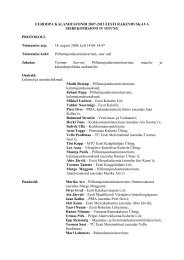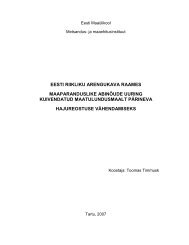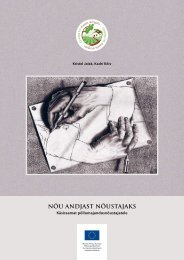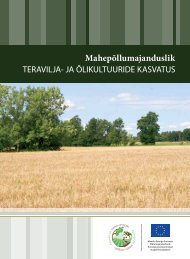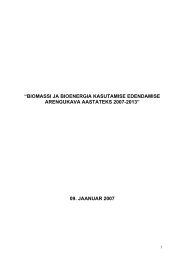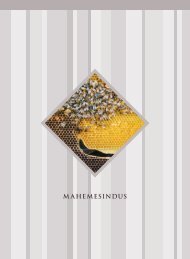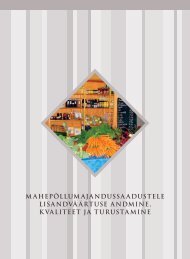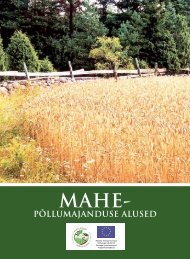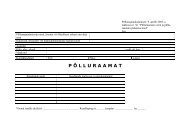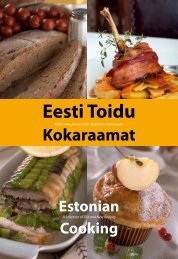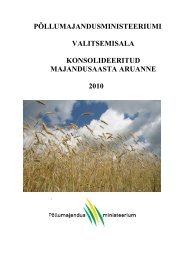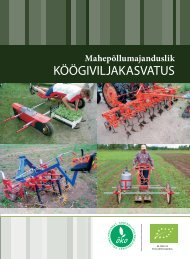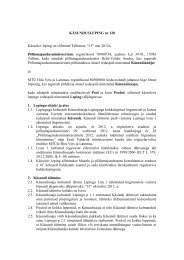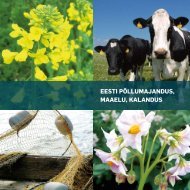You also want an ePaper? Increase the reach of your titles
YUMPU automatically turns print PDFs into web optimized ePapers that Google loves.
Sassi-Jaani farm – the yard of organic food and farming<br />
Our ancestors fertilized their fields with manure and did not<br />
know anything about herbicides or pesticides that would destroy<br />
weeds and vermin. Today, once again, one aims at growing<br />
pure food which has not been spoilt by chemicals.<br />
On this farmyard you can find a wide range of organic food:<br />
vegetables, dairy and meat products, juices, <strong>ja</strong>ms, different kind<br />
of meals, cereals, herbs and seasoning, honey, eggs, pastry, etc.<br />
In the kiln-room, a seminar is held to introduce principles of<br />
organic farming, advantages of organic food as well as different<br />
organic products and enterprises. It is possible to participate<br />
in the workshop of preparing organic food, consult on organic<br />
food and farming.<br />
On the farmyard it is possible to degust organic food and choose<br />
one’s favourite product.<br />
Köstriaseme farm – making of kiisel (sour flummery)<br />
Our forefathers used to make an interesting dish out of grain<br />
– a sour flummery named kile, kiisel or kisla. Oat flummery was<br />
the most widespread but the same dish could also be made of<br />
potato or rye.<br />
Pulga farm – potato printing and straw dolls<br />
Bread has been always held in honour and it has never been<br />
allowed to play with food. However, sometimes one can still<br />
make compromises in the name of a good idea.<br />
On this farm one can try out potato printing and making of a<br />
straw doll.<br />
Här<strong>ja</strong>pea farm – baking of bread and making of butter<br />
Everyone who has tried making bread at home knows that this<br />
is not an easy task. That must be the reason why home-baked<br />
bread tastes so good. As the saying goes, the more bitter the<br />
work, the sweeter the bread. Here one can get acquainted with<br />
different phases of making bread. It is possible to taste this<br />
week’s batch with freshly-made butter.<br />
Aarte farm – dried bread of the northern coast<br />
The way of life and food of people living on the northern coast<br />
was influenced by close contacts with Finland. The ordinary rye<br />
bread was not suitable for taking along to long voyages as it<br />
tended to mould. Instead, 3-4 weeks before starting to a trip of<br />
seasonal fishing one baked the so-called Finnish bread – thin<br />
round loaves with a hole in the middle. These loaves were dried<br />
under the ceiling and were eaten on the journey.<br />
On Aarte farm we bake Finnish bread, grind coffee beans that<br />
have been brought from over the sea and speak about the eating<br />
habits of coastal people.<br />
By Nätsi windmill – Potato Academy – everything you need to<br />
know about potatoes!<br />
It is possible to see and taste different sorts of potatoes, meet<br />
potato growers and try out potato dishes prepared by top chefs<br />
of Estonia.<br />
Counseling by specialists of potato growing. It is possible to<br />
buy domestic potatoes on the spot and make deals for storing<br />
winter provisions. Children can amuse themselves in an exciting<br />
handicraft corner dedicated to the potato. Choosing of visitors’<br />
favourite sort of potato!<br />
Kuie School – baking of sugar cakes and solving of puzzles<br />
In olden times there was no candy bowl standing on the table<br />
every day. Even finer rye bread was eaten only on bigger holidays.<br />
On days of the fair when farmers’ purses were filled with<br />
money earned from selling agricultural products, a sugar bun was<br />
bought as a present for each child.<br />
Kuie School is filled with sweet smells. The schoolmaster’s wife<br />
bakes buns for the children of Sunday school and kindly shares<br />
her family’s recipe. In the classroom it is possible to solve puzzles<br />
related to bread, potato and everything that can be seen in the<br />
museum on this day.<br />
Roosta farm – threshing, winnowing and grinding of grain<br />
Breadmaking was hard work, yet more difficult were the tasks<br />
that preceded this: reaping, threshing and milling by hand.<br />
On Roosta farm one is engaged with autumn chores: rye is<br />
threshed with flails, grain is winnowed and thereafter ground<br />
into meal for making bread. Most of the grain is later taken to the<br />
windmill.<br />
Jüri-Jaagu farm –<br />
sowing of winter rye and drinks made of grain<br />
Winter rye is not sown in spring, at the budding time of nature,<br />
but in autumn. So, rye needs almost the whole year to ripen for<br />
reaping. On Jüri-Jaagu farm one can observe the sowing of winter<br />
rye. This important task was trusted to the farmowner himself.<br />
The farmer’s brother gives advice how to make wine out of rye<br />
and beer out of barley.<br />
Kolga farm – children’s spectacle “He who does not work,<br />
neither shall he eat” by Miku-Manni Children’s Theatre.<br />
At 12.00, 14.00 and 15.00 o’clock.<br />
This is a funny story about a hen looking for companions to sow<br />
grain, grind flour in the autumn and bake buns.<br />
Is it easy to find helpmates or do friends show up only after the<br />
hard work has been done?<br />
Hill of windmills – exhibition “Windmills of Time”<br />
Photo exhibition by Hanno Talving introduces windmills<br />
through history.<br />
Rusi farm – roof making<br />
Our forefathers made use of the whole rye plant. Ears of corn<br />
provided one with bread, and rye straw made a good covering<br />
for the roof. Straw-thatched roofs are not made any more as it is<br />
difficult to get that long thatch. Instead, one makes reed roofs<br />
that were once common only on coastal areas and the islands.<br />
On Rusi farm the roof is made both by master thatchers and<br />
their apprentices. They test making of a reed roof and a shingle<br />
roof. They can also instruct about making a straw-thatched<br />
roof.<br />
In front of Kolu Inn<br />
11.00 accordian (karmoschka) pieces by Voldemar Ahone<br />
12.00 popular violin and accordian pieces by Enrik Visla<br />
and Juhan Uppin<br />
13.00 “Hõpõhõim” folklore group<br />
14.00 popular violin and accordian pieces by Enrik Visla<br />
and Juhan Uppin<br />
15.00 accordian (karmoschka) pieces by Voldemar Ahone<br />
15.45 winners of contests “Best organic producer 2010”,<br />
“Best organic product 2010” and “Visitors’ favourite<br />
organic product” are announced<br />
16.00 popular violin and accordian pieces by Enrik Visla<br />
and Juhan Uppin<br />
Seaside swinging square<br />
At 12.00, 14.00 and 15.30 performance of Kihnu Virve and<br />
Audru Jõelaevanduse Punt ensemble<br />
Sutlepa Chapel<br />
13.00 Blessing of the Bread by Pastor Toomas Paul<br />
15.00 “Sounds of the Nordic Islands” by Villu Veski and<br />
Tiit Kalluste<br />
Food fair along the main road and handicraft fair by the<br />
road taking to Sepa farm



